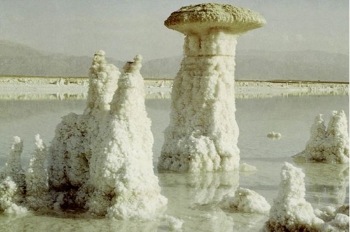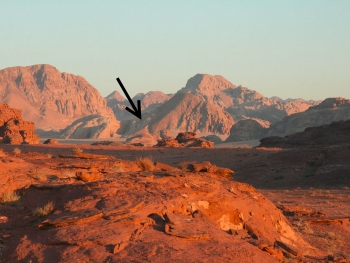wâ-Yei•râ′ 4th Eve

ä' Rained Down Flaming Godfire-stone On Sᵊdōm and A•mōr•âhꞋ
 |
As the sun was coming up over the land, Lōt was coming toward TzōꞋar. In the pre-dawn darkness, by the hands of the military forces of the ma•lâkh•imꞋ, ä' had rained down arrows tipped with flaming sulfur on the wood and thatch roofs of the mud brick buildings of both of the major cities along the southeast shore of Yâm ha-MëlꞋakh, Sᵊdōm and A•mōr•âhꞋ, creating a wildfire that trapped the inhabitants, consuming them along with all of the trees and brush.
Meanwhile, unnoticed by others in the caravan, Lōt's wife had stopped near Sᵊdōm to watch what would happen. She was caught in the fires and all they later found was a pillar of salt that reminded them of her – and commemorated the cost of her assimilation.
Lōt's Assimilated 'Daughters of Sᵊdōm'
 |
Because of Lōt's association with the ma•lâkh•imꞋ who had rained flaming Godfire-stone down on the cities of Sᵊdōm and A•mōr•âhꞋ, the residents of TzōꞋar and all of the surrounding peoples regarded him as an enemy. Consequently, Lōt and his two daughters lived in danger of being lynched by the townspeople. Afraid to remain in TzōꞋar, he and his two daughters moved back to the mountain that the ma•lâkhꞋ had indicated, just east of the ruins of Sᵊdōm.
Life was harsh living in the arid wilderness as a hermit family. The surrounding peoples were unfriendly, threatening and a danger. Cut off from all other humans, the girls realized that their prospects for marriage were zero. Looking ahead, the outlook for the girls after their father died would become even worse: facing the harsh life in the arid wilderness completely alone. Talking over their situation, the girls concluded that they only way they could survive would be to imitate the Egyptian royalty: have children by their father.
But the girls also knew that Lōt wasn't assimilated into the culture and morality the girls had always known in Sᵊdōm or Egyptian influences. So, without Lōt's awareness, the two girls conspired to get their father drunk in order to get pregnant by him; first one daughter, the next night the other daughter. So, the two girls became pregnant and each gave birth to a son. The eldest named her son Mo•âvꞋ and the younger of the two daughters called her son Bën-Am•iꞋ, the patriarch of the Bᵊn•eiꞋ-Am•ōnꞋ.11
Grazing & Water Rights
Avᵊrâ•hâmꞋ Negotiates With Greco-Minoan Philistine13 MëlꞋëkh Of Gᵊrâr12
 452x363.jpg) |
| Gᵊrâr12 (Tël Ha•rorꞋ12), southwest of Khë•vᵊr•onꞋ, between Hellenist Greco-Minoan Philistia13 and Bᵊeir ShëvꞋa and showing Mo•âvꞋ ( corrupted to "Moab") and Am•ōnꞋ (corrupted to "Ammon" and Arabized to Amman), capital of modern Jordan. (Hammond) |
Three months later,16 Avᵊrâ•hâmꞋ visited Greco-Minoan Philistine13 Gᵊrâr,12 which was a buffer zone between his lands and Greco-Minoan Philistia,13 to homestead. His growing ranching empire required expanding pasture and more water wells. Accordingly, he sojourned to the west of Bᵊeir ShëvꞋa to lay claim to additional grazing lands and to dig wells that would extend his grazing lands and rights – to the edge of Greco-Minoan Philistia,13 which neighbored him on the west. Avᵊrâ•hâmꞋ negotiated these land grazing rights with the local Greco-Minoan Philistia13 mëlꞋëkh — Avi-mëlꞋëkh.14
Just as earlier, when visiting Egypt,15 Avᵊrâ•hâmꞋ feared that, because SârꞋâh was so desirable, the Greco-Minoan Philistine13 mëlꞋëkh might have him killed so that he could have her. So Avᵊrâ•hâmꞋ – once again – arranged for her to pose as his sister.
Avi-mëlꞋëkh, having been advised how desirable SârꞋâh was, and being told that SârꞋâh was Avᵊrâ•hâmꞋ's sister, took her into his harem.
But something didn't compute for Avi-mëlꞋëkh. His subconscious misgivings expressed themselves in a dream – of Ël•oh•imꞋ warning him that he would die for having brought SârꞋâh into his harem, because she was the wife of a husband.
When Avi-mëlꞋëkh awakened the next morning, feeling very relieved that he had not approached SârꞋâh, he told his servants of his dream, and all of the men were terrified. Then Avi-mëlꞋëkh summoned Avᵊrâ•hâmꞋ and paid him recompense for the disrespect of his wife with gifts – 1,000 silver-coins plus yet more herds and staff to work the new areas (and, no doubt, arranging for the Greco-Minoan Philistines13 to stream back intelligence about Avᵊrâ•hâmꞋ's activities back to Avi-mëlꞋëkh).

Optional parental preparation:
- Note 9 – Of the two popular and traditional mountain rock formations usually pictured, beside being rock and not salt, one is on the wrong (west, Israeli) side of Yâm ha-MëlꞋakh from the archeological ruins of the destroyed cities and the other is on the wrong (north) end (opposite the direction from Sᵊdōm to TzōꞋar) of Yâm ha-MëlꞋakh. Both are certainly late Christian tourist "finds."

- Note 11 – Am•ōnꞋ – the patriarch namesake after whom the capital of modern Jordan, Aman, is named. These two sons of Lōt are the patriarchs of modern-day Jordanians.

- Note 12 – Archeologists identify ancient Greco-Minoan Philistine13 Gᵊrâr with Teil Ha•rorꞋ

- Note 13 – Scientists have demonstrated that the Philistines were Mycenaean-Greeks, Hellenists long before Alexandria (not Arabs!); "Sea People" who first migrated from Pilos (hence, Pilos-tines) in the Mycenaean province of Greece, to Santorini-Thera (the Minoans) and, after the island-volcano blew up (ca. B.C.E. ), migrated to Crete and the coastlands of the southeastern Mediterranean – the Egyptian Delta, Sinai and Canaan where they established a number of cities they named Pilos, becoming known as Pilostines (Philistines). In Canaan, they established a new (pre-Alexandrian) Hellenist country called Pilostia (Philistia; modern Gaza).

- Note 14 – Scripture doesn't explain why Avᵊrâ•hâmꞋ visited. However, if there had been a drought (famine), it would have been stated – since Scripture states that there was only one drought (famine) during Avᵊrâ•hâmꞋ's lifetime (bᵊ-Reish•itꞋ 26.1). Therefore, this visit wasn't due to a drought or famine. Major quarrels arising later in the area (bᵊ-Reish•itꞋ 21.25-33; 26.15-33) provide the clue as to the reasons, a priori, he was sojourning in this area.

- Note 15 – See Lëkh Lᵊkhâ 1st Eve

- Note 16 – Since the ma•lâkhꞋ promised that SârꞋâh would give birth at the same season the following year, and she conceives during this episode (21.1-2) – which, then, is 9 months prior to the indicated time of birth; i.e., 3 months after their initial visit.

Questions you might anticipate that your child might raise and be prepared to discuss:
- What is "fire and brimstone"? (burning sulfur)
Google+ registered author & publisher

